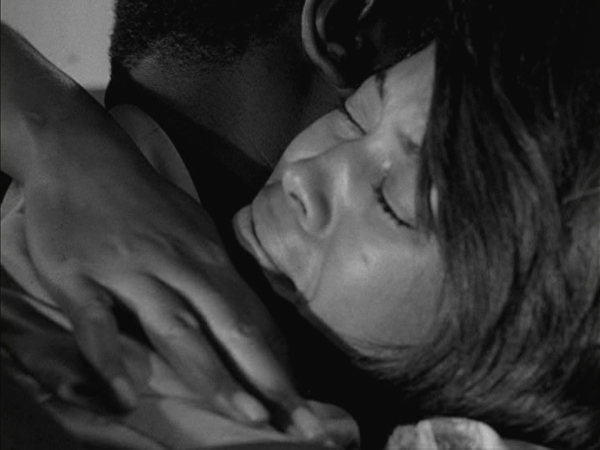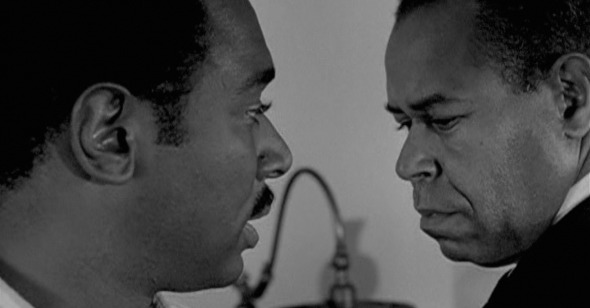Breathing Space
Ashley Clark on Nothing But a Man
Shot in glorious widescreen by cinematographer Bradford Young, Ava DuVernay’s historical drama Selma tells the story of the civil rights protests in Alabama in 1965 that led to the passage of the Voting Rights Act: a crucial piece of legislation which prohibited racial discrimination in voting. (The act, which remained unmolested for nearly 50 years, was effectively gutted in a controversial Supreme Court decision in June 2013.) Given the grand nature of the story the film is telling, Young’s choice to shoot in 2.35:1 with an anamorphic lens is apposite. His use of the full breadth of the frame is particularly striking in the three marches on the Edmund Pettus Bridge, which carry a mythical, almost Western charge; and the cathartic finale, when Dr. Martin Luther King Jr. (David Oyelowo) passionately addresses the crowd at a triumphant rally in front of the city’s courthouse. Though Selma is unusually and commendably concerned with the process and detail of politics and protest (in which respect it echoes Steven Spielberg’s Lincoln), it’s essentially a film of big decisions, high drama, and macrocosmic import. Only occasionally does it address the more personal, day-to-day impact of restrictive, discriminatory Jim Crow laws and ambient racism on everyday African-Americans. One early scene depicts this situation succinctly. Annie Lee Cooper (Oprah Winfrey), a middle-aged woman who will go on to become a respected activist, attempts to register to vote at her local courthouse. Yet the registrar has other ideas, and peppers her with a series of unanswerable qualifying questions, before denying her the right to register—this decision is amplified by DuVernay with an unsubtle yet effective close-up of a stamp punching the legend “DENIED" on Cooper’s application.
These kinds of mundane aggressions, and their suffocating spiritual effects, are the province of another drama set in almost the same time and place as Selma, but made 50 years before, with an entirely different visual approach. Michael Roemer’s Nothing But a Man (1964) tells the story of Duff (Ivan Dixon), a tough-minded, itinerant railroad worker in rural Alabama. He contends with explicit and implicit racism while attempting both to maintain a new marriage with Josie (Abbey Lincoln), the middle-class daughter of a disapproving local preacher (Stanley Green) with accommodationist tendencies; and to prosper in a hostile, restrictive job market which regards him as a second-class citizen at best. He is advised by colleagues to “play the nigger” in order to advance in a white world, but he has no interest in debasing himself in such a fashion. (It’s unsurprising to learn that the film was reportedly a favorite of Malcolm X.) Duff is referred to as “boy” by every white person he encounters: each casual utterance of that hard syllable chips away at his sense of self—despite his impressive reserves of inner-strength—and underscores the gravity of the film’s ostensibly understated title. Duff must also confront the specter of his drunkard father (Julius Harris), irrevocably soured by years of oppression; and the inconvenient fact of his estranged, illegitimate young son, whose mother, Duff discovers, has headed north in search of a better deal, leaving the boy in the care of a family friend.
Inspired by the approach of Italian neorealists like Vittorio De Sica and Roberto Rossellini, Roemer, with Nothing But a Man, explicitly seeks to illuminate contemporaneous conditions with an economical, documentary-like urgency. The film sprung from a period of intense research, during which Roemer and his longtime collaborator/cinematographer Robert M. Young spent two and a half months touring the segregated southern states in 1962, moving from one family and community to the next in order to learn as much as possible about their relationships and experiences. The director, who fled Nazi Germany as an eleven-year-old on the Kindertransports, explained his point of view in a 2013 interview: “It was showing how the economic system, the social system, destroyed the most intimate relationships. I saw it happen. It happened to Jews. It happened to my grandfather.”
In tandem with Roemer’s intimate observations, larger scale outrages were happening with an alarming frequency: the film was shot in 1963, the same year in which Mississippi civil rights activist Medgar Evers was murdered; and the racist bombing of 16th Street Baptist Church in Birmingham, Alabama, claimed the lives of four schoolgirls, an incident tackled by Spike Lee in his 1996 documentary Four Little Girls, and reimagined by DuVernay for Selma’s second scene. As with Selma (released in the wake of the police killings of Eric Garner and Michael Brown and the #icantbreathe and #blacklivesmatter protests), Fruitvale Station (about the police killing of Oscar Grant, and released in the same week that George Zimmerman was found not guilty of the murder of Trayvon Martin), Malcolm X (released in the wake of the L.A. riots provoked by the brutal police beating of Rodney King) and Do the Right Thing (directly inspired by the police killing of Michael Stewart), Nothing But a Man is part of a disturbingly perennial trend of films responding to the severe maltreatment of African-Americans which could accurately be described as “timely.”
Duff, then, is both a living, breathing character incarnated by the magnetically charismatic Dixon, and a microcosmic symbol of the complex social malaise of which he is a product. His status is brilliantly reflected in the film’s rigorous visual schema. The use of harsh, high-contrast monochrome is immediately notable (I was struck by its sharpness when I saw the film for the first time from a newly restored print in 2013; it suffered from distribution problems on release, and wasn’t seen widely until a first restoration in 1993). Furthermore, in order to evoke and emphasize Duff’s constant, corrosive lack of physical and mental freedom, Roemer and Young make the most of the boxy, 1.33:1 (or 4:3) ratio, which renders it as intimate as Selma is epic. Their choice is deliberate and inspired, for while 1.33:1 remained the TV standard, it had ceased to be the first choice in American cinema a decade prior, starting in 1953, when it was largely replaced by the wider ratio of 1.85:1. This was the ratio used in Daniel Petrie’s 1961 adaptation of Lorraine Hansberry’s A Raisin in the Sun, a play about the travails of a black family in the de facto segregated setting of Chicago’s South Side. It’s a comparably claustrophobic story of racism and frustrated expectation (its title comes from Langston Hughes’s poem “A Dream Deferred”: “What happens to a dream deferred? / Does it dry up / like a raisin in the sun?”), but Petrie’s visual treatment—heavy on mid-shots and faithful to Hansberry’s stage directions—allows for a sense of theatrical artifice and space to creep in. There is no such respite in Roemer’s film, which is clearly a major influence on Charles Burnett’s Killer of Sheep (1977): another tender, monochrome, 1.33:1 exploration of African-American family struggle which was barely seen for years until it was rescued by a restoration.
Roemer and Young populate Nothing But a Man’s frame with one finely wrought close-up after another, in which characters—whether it’s Josie’s unctuous father, quietly ashamed to be branded an Uncle Tom by Duff; or Duff’s own pickled, near-vagrant father, experiencing a slow death of the soul—cannot hide their feelings. It’s notable too that characters rarely enter the frame; rather, the camera finds them in situ, evoking stasis, while Luke Bennett’s fine editing stitches together intricate sequences of faces and bodies in dialogue with each other. The filmmakers also deliberately minimize the open space of the Deep South (actually the wilds of New Jersey, since filming with a black cast in the south was too dangerous in 1963.) There are a handful of shots of open sky, but rarely are they associated with escape; rather, they almost mockingly frame the railroad men hard at work in the blazing sun. The viewer is primed for the forthcoming grind by the symbolic opening shot: a low-angle close-up of a massive drill, framed by a pair of legs, ploughing noisily into a railroad track.
Throughout, Roemer and Young conjure a series of strikingly cramped tableaux, seemingly intent on reducing the space available in an already limited frame. This is most notable in the unbearably tense, locker-room scene where Duff is fired on the spot from his job at a mill, for refusing to compromise his principles—he has previously suggested to his cowed coworkers that they unionize. In addition to Duff and his white boss, there are up to eight men in shot, all further hemmed in by the intrusive metal lockers which line either side of the frame—any one of the men might have been responsible for ratting Duff out. (With regard to the film’s pungent atmosphere, special note should also be made of Robert Rubin’s exceptionally layered, detailed sound design; there’s no musical score except for the crickets outside conducting their atonal, assaultive symphony.)
The flipside of all this constriction is found in the tenderness between Duff and Josie, which Roemer amplifies by frequently capturing them together in the frame, or sequencing close-up dialogue and reaction shots along their eyelines. It helps that Dixon and Lincoln are extremely attractive, photogenic actors, while their electric chemistry is palpable: neither seems able to prevent a mischievous smile from playing upon their lips when they are in each other’s company. In some of their shared scenes—particularly their first kiss, which takes place in a car borrowed from Duff’s colleague—I’m reminded of the gorgeously protracted, tightly framed smooch between Devlin (Cary Grant) and Alicia (Ingrid Bergman) in Alfred Hitchcock’s Notorious. Devlin and Alicia’s erotic reverie, however, was not interrupted by a pair of lascivious, scowling racists, as is the case for Duff and Josie.
In The Fire Next Time (released the same year Nothing But a Man was shot), the great African-American essayist James Baldwin wrote, “To be sensual, I think, is to respect and rejoice in the force of life, of life itself, and to be present in all that one does, from the effort of loving to the breaking of bread.” Roemer’s rendering of Duff and Josie’s relationship is precisely an effort to convey both the necessity, and bravery, of such sensuality in a cruel climate; there’s hardly any space to breathe in this blighted world, but they find freedom in each other. When Duff, feeling emasculated after his second, desperately unfair job loss, snaps near the end of the film and hurls the pregnant Josie to the floor, the emotional effect is intensified thanks to the rupture of the physical proximity which has been built up between them through Roemer’s careful composition. And yet, we are delivered to togetherness once more in the pair’s extraordinarily moving final clinch, after Duff has returned home from burying his father and collecting his son. The framing, as ever, is mercilessly tight, but this time, instead of zeroing in on Duff, Roemer focuses on Josie, clutching Duff’s right shoulder, as tears—cascading, ambiguous rivulets of joy, pain, passion, terror, relief?—stream down her cheeks. Duff gets the film’s final, warily reassuring words (“It ain’t gonna be easy, but it’s gonna be alright…”), but Roemer gives the moment over to this relentlessly bold, supportive woman: in a film full of unforgettable faces, hers is the one that lingers in our mind as that boxy frame fades to black and the lights come up. At this point, it feels okay to breathe again.

Nothing But a Man played Saturday, March 7, 2015 at the Museum of the Moving Image as part of See it Big! High and Wide, a series co-programmed by Reverse Shot and Museum of the Moving Image.
